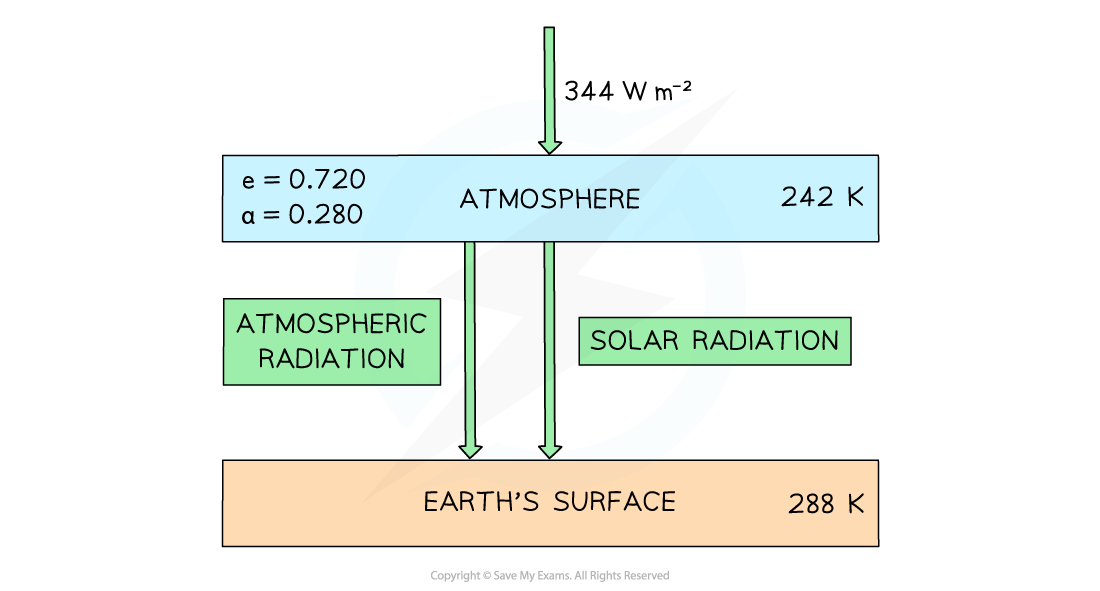Energy Balance Problems (DP IB Physics) : Revision Note
Energy Balance Problems
It is useful to consider Earth’s energy balance in terms of how much incoming energy from the Sun is used and how much is returned to space
If incoming and outgoing energy are in balance, the Earth’s temperature will remain constant
This can be used to create models which can help climate scientists predict temperature fluctuations based on current and increased concentrations of greenhouse gases
At it’s simplest, the model involves a one-layer atmosphere above the Earth’s surface
Worked Example
The diagram below shows a simple energy balance climate model in which the atmosphere and the Earth’s surface are treated as two bodies.

The Earth’s surface receives both solar radiation and radiation emitted from the atmosphere.
At current atmospheric greenhouse gas concentrations, the temperature of Earth’s atmosphere is set to increase by 6 K.
Data for this model:
Current mean temperature of the Earth’s atmosphere = 242 K
Current mean temperature of the Earth’s surface = 288 K
Solar intensity per unit area at top of the atmosphere = 344 W m–2
Emissivity of the atmosphere, e = 0.720
Albedo of the atmosphere, a = 0.280
Use this data to estimate the increase in temperature of the Earth’s surface.
Answer:
Step 1: List the known quantities
Solar intensity above atmosphere, Ia = 344 W m–2
Emissivity of the atmosphere, e = 0.720
Emissivity of the surface, e = 1
New temperature of Earth’s atmosphere, Ta = 242 + 6 = 248 K
Stefan-Boltzmann constant, σ = 5.67 × 10–8 W m–2 K–4
Intensity absorbed at the Earth’s surface = Is
New temperature of Earth’s surface = Ts
Step 2: Calculate the solar intensity absorbed at the Earth’s surface
This can be calculated using the emissivity and the solar intensity above the atmosphere
Is = e × Ia
Is = 0.720 × 344 = 247.68 = 248 W m–2
Step 3: Write the equation for the power per unit area emitted by a body
Since intensity = power per unit area
I = eσT4
Step 4: Calculate the new intensity radiated by the atmosphere
I = 0.720 × (5.67 × 10–8) × 2484 = 154.43 = 154 W m–2
Step 5: Calculate the new intensity absorbed by the Earth’s surface
The intensity absorbed by the Earth’s surface is a sum of the solar radiation that reaches the surface plus the intensity radiated by the atmosphere
New intensity, Is = 248 + 154 = 402 W m–2
Step 6: Calculate the new temperature of the Earth’s surface
The Earth’s surface can be assumed to be a black body, hence e = 1
Is = σTs4
400 = (5.67 × 10–8) × Ts4
Ts = = 290 K
Step 7: Determine the increase in temperature
ΔT = 290 – 288 = 2 K
Examiner Tips and Tricks
In simplified climate models, you can generally assume the Earth’s surface and the atmosphere:
Act as black bodies - this means the emissivity of the surface will be equal to 1!
Remain at a constant temperature

You've read 0 of your 5 free revision notes this week
Sign up now. It’s free!
Did this page help you?
